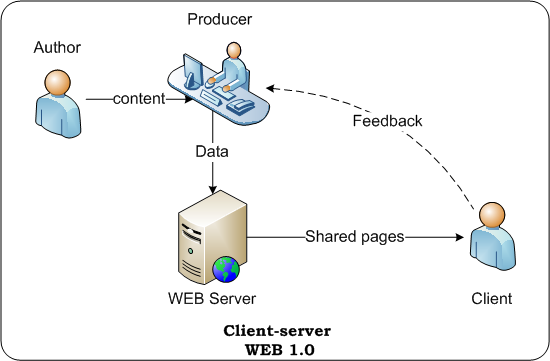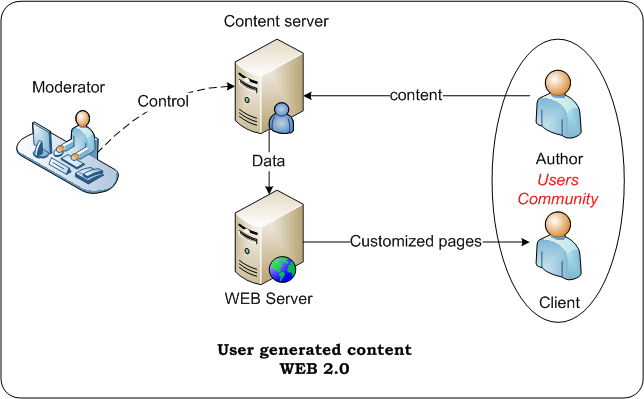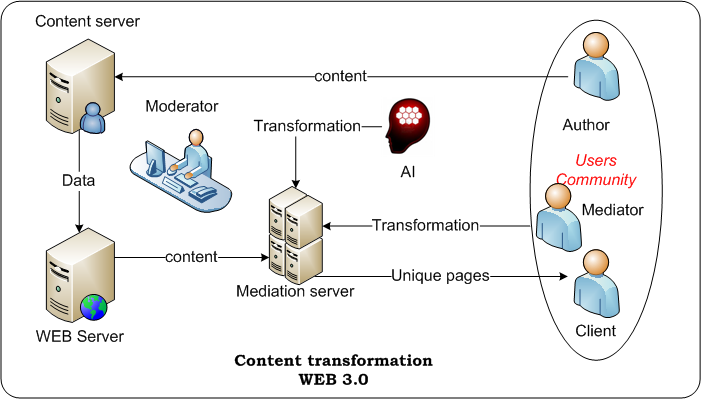WEB 3.0
For over a year I have been working on an interesting and controversial project in the field of e-commerce. The work on a particular case of a very global task, as well as periodically arising misunderstanding of the results even among experienced professionals, led to the idea of creating some generalization of the accumulated ideas.
In my generalization, I aim at the definition of WEB 3.0 technology! After the success of the principles of WEB 2.0, it would be strange if the nameplate 3.0 were not dragged by a variety of visionaries to their definitions. However, in their attempts they drew a typical “better 2.0”. An attempt to increase the version number with the help of such epithets as “beautiful”, “professional” is nothing more than marketing husk!
An example of such nonsense is the current version numbering of Firefox versions. I rarely use it, only to view the layout of new versions of projects. At each launch, it turns out that the version has changed and some buttons in the menu have changed places.
Recognition of the new version can only be justified by a technological leap in the key area for web services - the creation and processing of information (content). This jump can not be "more beautiful" or "more professional", it can only be fundamentally different technologically.
')
My belief is that the key feature of WEB 3.0 will be “content transformation”, which will change not only the design and development of web applications, but also the concept of copyright, and lead to the transformation of business models of existing services.
Already wanted to argue? Then well under the cat!
Before looking into the future, you need to deal with what we have.

Good old Web, which created the foundation and all the terminology based on the concepts of client - server. There is a consumer of information - a client, there is a producer of information - a professional journalist (writer, director, producer, archive). The producer decides what might be interesting to the consumer. The consumer can write a review by e-mail, and more often he simply votes with his feet when leaving for another resource.
In 2000, I worked as a news editor for one computer site. About 1,000 visitors read each news, but the response via e-mail was rare and a real holiday! It was a consolation that classic writers could count on recognition only after death.
Electronic libraries, news sites, online newspapers - these are classic examples of good old WEB services.
As it developed and expanded, the worldwide Internet network absorbed all new users. One of the first to come to the network were educated professionals, the so-called creative class. They began to create communities of interest - the community that formed around web-forums. These active groups could not put up with the fate of passive consumers of content for a long time and made a revolution - they created WEB 2.0.

The key difference in the new version of the Web was the principle of content creation, instead of the despotic Editor in Chief, the inconspicuous Moderator. In the best projects, the Moderator has become as inconspicuous as the UFO.
LiveJournal projects, LiveJournal, Wikipedia and of course the much-loved Habrahabr can be called successful examples. The quintessence of the community idea was social networks.
The existing growth of the global Internet is fueled by two factors:
The first trend objectively dictates the need to create personalized versions of the display of various sites. This task even gave rise to the term content adaptation , which is defined as a way of transforming content to adapt to the technical capabilities of the playback device .
The second trend leads to the emergence of "cultural adaptation", the most obvious version of which is translation into a foreign language. However, there are other adaptation options, such as filtering obscene content. The most famous example of such an adaptation is the great Chinese fairvol .
What should the technology look like that meets the challenges of WEB 3.0?
A small comment to the pseudo-liberals, who certainly excited the mention of Chinese censorship. In my interpretation, WEB3.0 does not cut off or filter any source information; instead, a new projection is created - a new site with adapted content. Thus, instead of restricting or dividing the Internet, another degree of freedom is created — for example, the freedom to receive and read information in the language that is accessible to the reader, and with those restrictions that he deems acceptable to himself. The new projection honestly and openly competes with the original and other interpretation options.
I would venture to depict this in the diagram:

In full accordance with the complexity of the modeled reality in the new scheme, an intermediate layer arises, which I called the term Mediation. This term has extensive experience in the field of telecommunications and law and fully discloses the essence of the action. Mediation server based on the original content (text) forms a different projection of reality . It can be either a translation of a journal article from English into Chinese, or a correction of an obscene blog by Tebe Lebedev's Russian literary, or a language accessible to younger students.
Mediation server can be managed through machine intelligence, for example, using Summly (an innovative web text processing startup created by a 15-year-old British prodigy, invested by an 89-year-old Chinese billionaire) or Abby Compreno .
An alternative way of forming Mediation with the help of mediators, whose work is based on crowdsourcing and scoring Web2.0.
Boil brains? No problem! Leave the hi-tech slang and try to draw with your finger Wikipedia 3.0.
The one who read the article before this place is a hero who deserves a reward!
Dear Habrauzer! Imagine that a kind genie will fulfill one of your wishes - it will start the Web 3.0 service, but with the condition! It should be an amazing, bright and cool project. So that anyone who came to the page of the project immediately exclaimed “Wow, cool!” And sent the link to his 33 friends.
Below is a partial list of ideas, with a grumpy genie’s comment.
When the genie disappeared, some strange entries were found: Nginx, Lua, PCRE, Redis NoSQL, persistent cache, hash map, key-value, 10K requests. Looks like some strange spells!
In my generalization, I aim at the definition of WEB 3.0 technology! After the success of the principles of WEB 2.0, it would be strange if the nameplate 3.0 were not dragged by a variety of visionaries to their definitions. However, in their attempts they drew a typical “better 2.0”. An attempt to increase the version number with the help of such epithets as “beautiful”, “professional” is nothing more than marketing husk!
An example of such nonsense is the current version numbering of Firefox versions. I rarely use it, only to view the layout of new versions of projects. At each launch, it turns out that the version has changed and some buttons in the menu have changed places.
Recognition of the new version can only be justified by a technological leap in the key area for web services - the creation and processing of information (content). This jump can not be "more beautiful" or "more professional", it can only be fundamentally different technologically.
')
My belief is that the key feature of WEB 3.0 will be “content transformation”, which will change not only the design and development of web applications, but also the concept of copyright, and lead to the transformation of business models of existing services.
Already wanted to argue? Then well under the cat!
Before looking into the future, you need to deal with what we have.
WEB 1.0

Good old Web, which created the foundation and all the terminology based on the concepts of client - server. There is a consumer of information - a client, there is a producer of information - a professional journalist (writer, director, producer, archive). The producer decides what might be interesting to the consumer. The consumer can write a review by e-mail, and more often he simply votes with his feet when leaving for another resource.
In 2000, I worked as a news editor for one computer site. About 1,000 visitors read each news, but the response via e-mail was rare and a real holiday! It was a consolation that classic writers could count on recognition only after death.
Electronic libraries, news sites, online newspapers - these are classic examples of good old WEB services.
WEB 2.0
As it developed and expanded, the worldwide Internet network absorbed all new users. One of the first to come to the network were educated professionals, the so-called creative class. They began to create communities of interest - the community that formed around web-forums. These active groups could not put up with the fate of passive consumers of content for a long time and made a revolution - they created WEB 2.0.

The key difference in the new version of the Web was the principle of content creation, instead of the despotic Editor in Chief, the inconspicuous Moderator. In the best projects, the Moderator has become as inconspicuous as the UFO.
LiveJournal projects, LiveJournal, Wikipedia and of course the much-loved Habrahabr can be called successful examples. The quintessence of the community idea was social networks.
WEB 3.0
The existing growth of the global Internet is fueled by two factors:
- The outrunning growth in the number of mobile devices for network access
- Advance growth of subscribers in developing and underdeveloped countries, with strong cultural differences.
The first trend objectively dictates the need to create personalized versions of the display of various sites. This task even gave rise to the term content adaptation , which is defined as a way of transforming content to adapt to the technical capabilities of the playback device .
The second trend leads to the emergence of "cultural adaptation", the most obvious version of which is translation into a foreign language. However, there are other adaptation options, such as filtering obscene content. The most famous example of such an adaptation is the great Chinese fairvol .
What should the technology look like that meets the challenges of WEB 3.0?
A small comment to the pseudo-liberals, who certainly excited the mention of Chinese censorship. In my interpretation, WEB3.0 does not cut off or filter any source information; instead, a new projection is created - a new site with adapted content. Thus, instead of restricting or dividing the Internet, another degree of freedom is created — for example, the freedom to receive and read information in the language that is accessible to the reader, and with those restrictions that he deems acceptable to himself. The new projection honestly and openly competes with the original and other interpretation options.
I would venture to depict this in the diagram:

In full accordance with the complexity of the modeled reality in the new scheme, an intermediate layer arises, which I called the term Mediation. This term has extensive experience in the field of telecommunications and law and fully discloses the essence of the action. Mediation server based on the original content (text) forms a different projection of reality . It can be either a translation of a journal article from English into Chinese, or a correction of an obscene blog by Tebe Lebedev's Russian literary, or a language accessible to younger students.
Mediation server can be managed through machine intelligence, for example, using Summly (an innovative web text processing startup created by a 15-year-old British prodigy, invested by an 89-year-old Chinese billionaire) or Abby Compreno .
An alternative way of forming Mediation with the help of mediators, whose work is based on crowdsourcing and scoring Web2.0.
Boil brains? No problem! Leave the hi-tech slang and try to draw with your finger Wikipedia 3.0.
Wikipedia 3.0 - what could it be?
- The new Wikipedia no longer needs separate national sites. The unified structure of the encyclopedia has been translated into a different language with varying degrees. Missing translations creates machine intelligence. Machine translation is adjusted by native speakers as a result of which the algorithm is trained.
- Lurk is no longer a separate encyclopedia, its projection inside. As well as many other new projections.
- Wikipedia projections are available for any group of devices - for 80-character cell phones or twitter readers.
- Any visitor can either read the selected projection, or turn on the crowd-editing mode of the projection / article / paragraph and vote for someone else's proofs. Or you can become an editor and make your own changes.
- Projections are formed from the most popular edits based on the rating of their author and the vote of the crowd editors.
- Projections are formed on the fly by interpolating edits for a different period of time - if you want to have the most relevant, if you want, you will get the most approved for the last year.
- There are no more editors' wars - any projection has the right to life if it is read and voted for. Old projections disappear on the principle of the least used.
Cake
The one who read the article before this place is a hero who deserves a reward!
Dear Habrauzer! Imagine that a kind genie will fulfill one of your wishes - it will start the Web 3.0 service, but with the condition! It should be an amazing, bright and cool project. So that anyone who came to the page of the project immediately exclaimed “Wow, cool!” And sent the link to his 33 friends.
Below is a partial list of ideas, with a grumpy genie’s comment.
- Make a karma to authors like on Habré (there’s not enough money for hosting project servers)
- To make an automated translation of the LJ blog of Artemy Lebedev into a literary language (you will get the LJ from Boris Akunin)
- Translate Habrahabr into English (digg is still shorter)
- Enable anonymous users to vote for karma on Habré (the world is not ready for this yet)
- Take some kind of jobboat, but tie a ribbon with comments and rating to it so that you can cut the whole truth of the womb (hantim.ru - simply and with taste, like a genie!)
When the genie disappeared, some strange entries were found: Nginx, Lua, PCRE, Redis NoSQL, persistent cache, hash map, key-value, 10K requests. Looks like some strange spells!
Source: https://habr.com/ru/post/143912/
All Articles